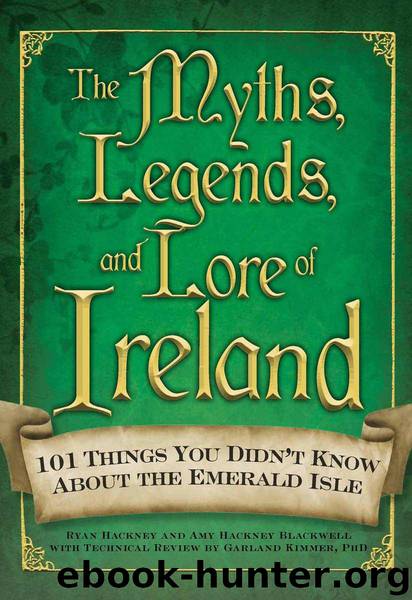The Myths, Legends, and Lore of Ireland by Blackwell Amy Hackney

Author:Blackwell, Amy Hackney [Blackwell, Amy Hackney]
Language: eng
Format: epub
Tags: FICTION / Fairy Tales, Folk Tales, Legends and Mythology, HISTORY / Europe / Ireland
Publisher: F+W Media, Inc.
Published: 2010-12-17T13:00:00+00:00
64 { Irish Music
There has been a major upsurge of interest in traditional Irish music in recent years. Bands like The Chieftains and Clannad have helped develop a worldwide interest in the lyrical sound of Celtic music. Musicians throughout Ireland and its emigrant communities have found opportunities to play for adoring crowds in Irish pubs everywhere. These musicians are continuing in a Celtic music tradition that goes back many centuries.
Poets and bards were big shots in Celtic societies. A good poet could grant either fame or shame to Celtic nobles, so when one showed up at court and started to sing, everyone gathered to listen. These bards often played harps and other musical instruments. Brian Boru’s harp — the symbol of Ireland — was supposedly played to rally his troops.
The singing poets continued their cultural influence after the Norman Conquest. The Anglo-Norman nobles, like the old Irish nobles before them, recognized the power of a good song, so they often sponsored these bards in their courts. Over time, however, the power of the bards waned. With books and letters available, nobles no longer needed poets to spread their fame.
Irish music is a free-form style. The length, pace, and musical composition of a given piece will change from night to night and from group to group. Traditional musicians almost never play from written music; in the past, many of the best musicians couldn’t even read music. As in Ameri- can jazz, most pieces revolve around group performances that highlight the virtuosic improvisations of individual musicians.
Despite the free-form style, Irish music has a distinctive sound that makes it immediately identifiable (although Scottish and Welsh music sound similar). The distinctiveness comes largely from the mix of instruments used. The traditional instruments of Irish music are:
Harp
Bodhrán drum
Fiddle
Flute
Tin whistle
Accordion
Bagpipes or uilleann pipes
Pretty much anything that can jam
Traditional music performances are informal. They generally take place in pubs, with the musicians performing only for free beer and the cheers of the crowd. Members of the audience can join in if they have a fiddle, a good voice, or even just a set of spoons to add to the music.
The Irish love of poetic language mixed with humor and tragedy to produce the beautiful Irish ballad. The ability to compose and perform a beautiful ballad has been highly prized in Ireland for centuries. The ballad is generally sung by a single person, who may or may not be accompanied by instruments. Ballads range from a handful of lines to many hundreds of lines in length. They can tell stories of lost love, injustice and revenge, or what happened when the singer went to get a beer.
Download
This site does not store any files on its server. We only index and link to content provided by other sites. Please contact the content providers to delete copyright contents if any and email us, we'll remove relevant links or contents immediately.
| Africa | Americas |
| Arctic & Antarctica | Asia |
| Australia & Oceania | Europe |
| Middle East | Russia |
| United States | World |
| Ancient Civilizations | Military |
| Historical Study & Educational Resources |
Room 212 by Kate Stewart(4739)
The Crown by Robert Lacey(4573)
Endurance: Shackleton's Incredible Voyage by Alfred Lansing(4507)
The Iron Duke by The Iron Duke(4122)
The Rape of Nanking by Iris Chang(4023)
Killing England by Bill O'Reilly(3898)
Joan of Arc by Mary Gordon(3784)
Say Nothing by Patrick Radden Keefe(3725)
I'll Give You the Sun by Jandy Nelson(3273)
Shadow of Night by Deborah Harkness(3176)
Hitler's Monsters by Eric Kurlander(3164)
Mary, Queen of Scots, and the Murder of Lord Darnley by Alison Weir(3066)
Blood and Sand by Alex Von Tunzelmann(3056)
Darkest Hour by Anthony McCarten(3018)
Margaret Thatcher: The Autobiography by Thatcher Margaret(2971)
Eleanor & Park by Rainbow Rowell(2943)
Red Famine: Stalin's War on Ukraine by Anne Applebaum(2816)
Book of Life by Deborah Harkness(2720)
The One Memory of Flora Banks by Emily Barr(2685)
